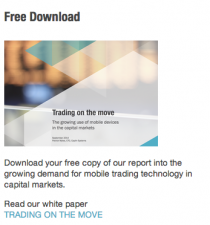In the past, perceived wisdom had been that bank trading platforms are for trading, whilst their research portals were for in-depth research – and never the twain shall meet.
And whilst many banks pay lip service to integrating pre-trade research with execution within their trading platforms, few get round to actually doing it, and fewer still do it well.
Many banks (and certainly our clients) produce world class proprietary research, across all global markets including FX, Rates, Fixed Income, Credits, Equities, Commodities and many other markets. This research combines fundamental, technical and quantitative data and in the case of large custodial banks seeing real-time capital flows via their platforms to produce in-depth research, intuitive trading ideas, and event driven market strategies.
Typically research has been provided to institutional clients via a separate research portal, where comprehensive research and analytical tools enabled clients to customise the bank’s in-house proprietary analytics and carry out ‘what-if’ analysis as part of the pre-trade intelligence and strategy formulation process.
By way of background, in 2003, regulators required financial services firms to ‘unbundle’ and make explicit the cost of research from the all in cost of execution, and barred banks from using investment banking revenues to compensate research staff. This was done in order to insure ‘best execution’ and address potential conflicts of interest, where fund managers directed execution towards banks that provided ‘free research’ via soft dollar arrangements. Of course, buy-side firms balked at the cost of the research, and as a result, many banks cut back on analysts, many of whom incidentally then set up independent research boutiques, providing unbiased research.
These changes have meant that research has to pay for itself, and the challenge for many banks since then has been to demonstrate and ‘measure’ the effectiveness of in-house produced research in terms of increased trade flows from those clients.
However, what often happened in the past was that clients were provided with excellent research and trade ideas and in many cases, then executed the trades on another bank’s trading platform.
That’s all changing now.
Integrating ‘relevant research’ into trading workflow:
Banks are now beginning to unlock the jewels held within their research portals and are integrating relevant ‘thin slices’ from these portals directly into the trading workflow of their trading platforms. Rather than users having to go and find research, platforms are instead pushing relevant research into the existing trading workflow within their platform.
The challenges for the banks is finding innovative and intuitive ways to deliver the right amount of research, in a way that it can be easily consumed and acted on quickly by the client (so that resulting trades are done within the platform.)
In addition, some banks are also looking to supplement gaps in internally produced research, by integrating 3rd party research and trade ideas from some of the global news/research providers, to round out or fill gaps in their own event driven content.
A couple of quick wins for banks are:
Research Alerts: Platforms that can alert users to new trade ideas and relevant research for an instrument, from within the pricing grids for the particular instrument. The trade idea is served up to users (with links to deeper research if required), and then the workflow seamlessly moves from pre-trade analysis to trade execution – all within the one platform.
Live video & interactive chat: Daily commentaries and event driven strategist briefings are streamed to the platform, together with interactive chat with sales and market strategist teams. The immediacy of this experience as well as providing market intelligence and ‘colour’ directly to the user provides a compelling service, drawing them in, and helping to add value to the portal.
Measuring Value of Research:
Whilst convergence or research and trading will add value to the clients, banks need to demonstrate, and measure that their research actually leads to increased trade flow within the platform.
The portal should be able to deliver MIS tools to measure the efficacy of research by providing a feedback loop, between the clients consuming the research and the resultant trade executions within the platform. This is of particular importance when a bank is delivering research in multiple formats (interactive tools, pdf docs etc), where the feedback can show that specific types of research are suitable for specific client types, when correlated with resulting trade flows.
So research can enable a bank to differentiate its platform, and make it ‘stickier’, by delivering greater value to their clients. This together with a feedback loop ensures that the bank improves the efficacy of the research and many other functional tools that the bank deploys within its portal.
Filed under: FX, Single-Dealer Platforms | Tagged: FX, Research, SDP, single-dealer platform |



[…] Some banks are learning, and they are now thinking how they can convert what was ‘just’ an execution platform, into a rich Relationship Channel. In order to make platforms more intuitive and stickier, banks are starting to integrate their research (see research and trading converge to make SDPs stickier). […]
[…] this: (1) it obviously makes sense to try and capture a client’s business there and then, by providing a smooth and easy route from research into execution; and (2) the research divisions want to justify their cost by associating themselves directly with […]
[…] So, how should bank approach the integration of research with execution? […]
[…] also been a challenge for many banks to integrate research into trading in such a way that they can metricate the value of their research, through subsequent client […]